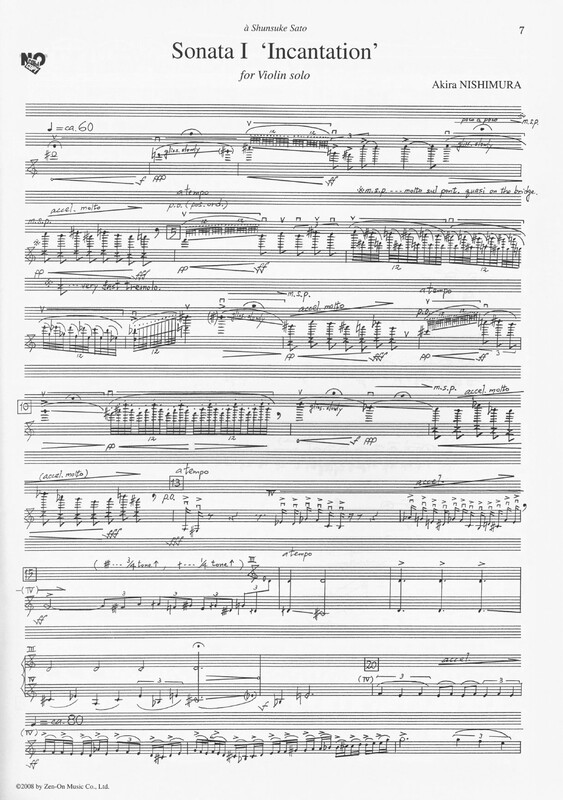Mubansō Vaiorin Sonata: Sonatas for Violin solo
Item
-
Score title
-
Mubansō Vaiorin Sonata: Sonatas for Violin solo
-
Composer
-
Akira Nishimura
-
Program note
-
Akira Nishimura
Sonata I 'Incantation' for Violin solo
An incantation is used as the theme of this piece; a kind of fantasia. Among the catalogue of Anatol Konstantinovich Liadov (1855-1914), the Russian composer, we can find the titles of symphonic poem, such as ‘Baba-Yaga, op.56' and 'Kikimora, op.63', of which a slight comical witch and a demon appear in the works. In composition of this piece, I tried to write a fantasia adopting such slight occult idea. The music begins from the higher range, and then, it goes to the lower range. These two musical scenes are united in the middle range after they continuously and opposite shifted, and an 'incantation' is appearing there. It is absolutely dissolemn, and is extremely rapid talking together with a murmur trembling caused by a morbid chill. At the end, it disappears like a small tornado. The microtones are used here and there in this piece, and frequently it deviates from chromatic scale of twelve-tone.
Sonata II 'Trance Medium' for Violin solo
A trance medium is used as the theme of this piece; a kind of fantasia. The said 'trance medium' means a person who has a special ability to contact with the soul of a dead person for a living ordinary human. On the conditions of the trance medium, there exist four levels as follows: firstly, it is at a standstill, secondly, it is complications between characters of the trance medium and the dominant medium, thirdly, it is perfect appearance of the dominant medium, and fourthly, the soul of a dead person (a possessed state) through the dominant medium as a mediator is appear. Despite of the purposes of this music is not drawing such process, it is a fact that my consciousness on an atmosphere of a supernatural ceremony by the trance medium more influenced to the music.
Sonata III 'Characters of Flame' for Violin solo
A stream of movement and sound of the tone of this piece are expressing a figure of violent rolling flame and its heat. An image of the flame is deepened upon the flame of Homa in Esoteric Buddhism (holy fire for invocation). The tip of the flame of Homa keeps on changing its figure violently dancing, and produce the letter-figures of light. Such letters of light express various Bodhisattvas. This fantastic piece was composed as a hymn to Homa.
 Akira Nishimura
Akira Nishimura

